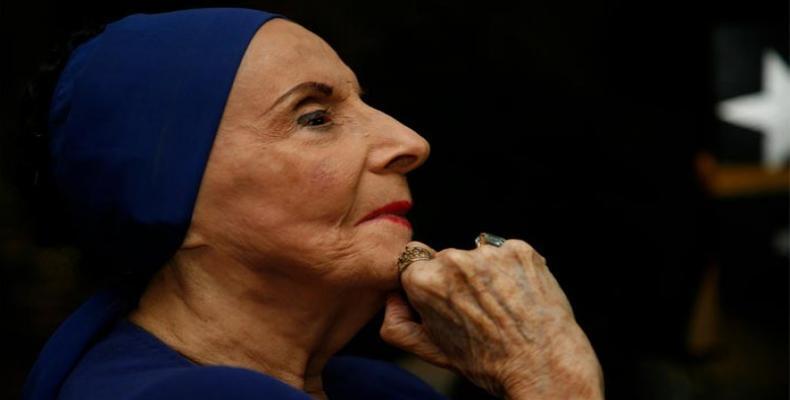Havana, October 17 (RHC) -- Alicia Alonso, most likely the best ballerina of the 20th century, is an inspiration for the hundreds of Cuban ballet dancers who graduate on the island’s ballet schools each year. A legend, a famous Cuban and universal ballet star and one of the world’s best known and admired ballerinas, choreographers and teachers, until her death she was the Director of the Cuban National Ballet Company, set up in 1948, and the most important dancer in classical ballet in the Spanish speaking world and one of the most outstanding artists in the history of dance.
Alicia, as she is called by Cubans and fans, was born in Havana on December 21st, 1920. Named Alicia Ernestina de la Caridad del Cobre Martínez del Hoyo, she started her ballet training at the Sociedad Pro-Arte Musical (Pro-Musical Art Society) in Havana in 1931 and continued her studies in New York at the School of American Ballet. Alonso began her professional career in Broadway musicals, such as Great Lady in 1938 and Stars in Your Eyes in 1939. Though already suffering from sight problems, the great ballerina was one of the main stars of the Ballet Caravan and later of the American Ballet Theater. In 1939, she was a soloist with the Ballet Caravan, the antecedent of the current New York City Ballet, and in 1940, the year of its establishment, Alicia joined the American Ballet Theater. As of that moment, a brilliant and successful career started as a top performer of classical and romantic ballets.
With the Ballet Theater Alonso danced in Antony Tudor’s Undertow in 1945; in 1947 George Balanchine created his Theme and Variations for her and Igor Youskevitch, with whom she firmed up a great partnership, and danced in the premier of Agnes de Mille’s Fall River Legend. As an American Ballet Theater leading dancer, she went on different European and Latin American tours. Her early contribution to the art of dance in the United States, at the beginning of the development of this artistic expression in that country, has been recognized by many.
Interested in developing ballet on the Caribbean island, she created Cuba’s first professional ballet company in 1948 –the Alicia Alonso Ballet-, called Ballet de Cuba (Ballet of Cuba) in 1955 and today known as Ballet Nacional de Cuba or Cuban National Ballet Company. At that time, she divided her artistic career between the American Ballet Theater and the Alicia Alonso Ballet. Her company didn’t have enough official support until 1959 when the Cuban Revolution triumphed. From 1959 on, as Cuban National Ballet prima ballerina, she became the soul of the Cuban School of Ballet, which included figures, such as the so called ‘four jewels’ of the Cuban Ballet: Mirta Plá, Loipa Araujo, Josefina Méndez and Aurora Bosh; and others such as Marielena Llorente and Marta García later.
Alicia’s choreographies are famous all over the world and performed by important companies, such as her version of Giselle, the Grand Pas de Quatre and The sleeping beauty danced by the Paris Opera Ballet; her Giselle performed by Vienna’s Opera Ballet and San Carlo of Naples; La fille mal gardée by Prague’s Opera Ballet and her version of The sleeping beauty by the Ala Scala Ballet of Milano.
She was one of the creators of the famous Cuban Ballet School, along with her former husband, Fernando Alonso -the schools’ main creator-, and Alberto Alonso. The school has earned admiration by the quality of its syllabus, teaching method and selection system and its members have been awarded and praised all over the world.
Due to her impressive artistic career she received numerous decorations and awards, including a Doctor’s Degree in Arts at the University of Havana and the Higher Institute for the Arts or Cuban Art University –ISA-; the Picasso Medal granted in 1999 by UNESCO, which appointed her ‘good will ambassador.’
In 1993, she was given the Isabel la Católica Order by the King of Spain, Juan Carlos de Borbón; the Republic of France awarded her with the Order of Arts and Literature and the Council of States of the Republic of Cuba named her ‘Labor Hero’ and honored the great ballerina with Cuba’s highest top medal – the José Martí Order- in 2000 and her country’s Foreign Ministry designated Alicia ambassador of the Republic of Cuba. She created the Dance Desk at Madrid’s Complutense University in Spain and was the President of the Alicia Alonso Foundation based in the Spanish capital.
Alicia Alonso performed during most of her successful career with sight problems or blind. She stopped dancing in the early 1990’s and continued to be an active choreographer and successfully directed the Cuban National Ballet Company until her death. Alicia Alonso is and continues to be an inspiration and guide to the new generations of Cuban dancers and artists. Her very personal style greatly influenced her company, the Cuban National Ballet, which has earned a major stature and prestige among the world’s top such ensembles and international dance institutions.


